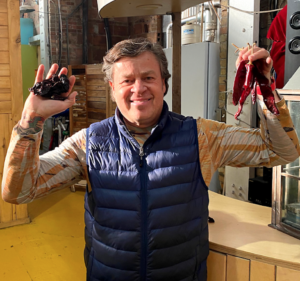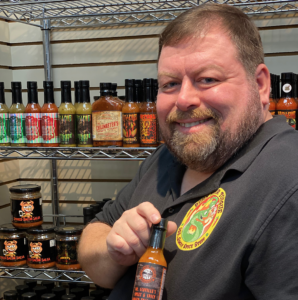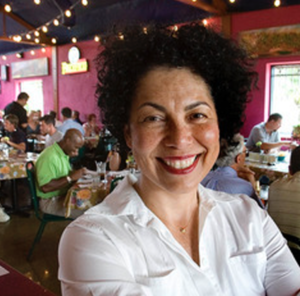Sixteen years ago I moved to Utah and was greeted with two jokes: first, that all spicy food was intercepted at the state border and dusted down with a mythical “blanding agent,” and second, that Utahns had invented fry sauce because ketchup alone without mayo to cut it was too picante.
Fast forward to 2020, and a sudden awareness that I am now somewhat immersed in a totally unexpected spicy food culture here in the former Land of Bland. There are now native-sprung Utah hot sauce companies and peppery condiments and jellies coming out of kitchens all over the state.
It’s not just in Utah. Nationally, and perhaps internationally, spicy food is having a moment. The overwhelming popularity of the YouTube show Hot Ones is a marker for this phenomenon—in it, host Sean Evans interviews celebrities while both consume a succession of spicier and spicier chicken wings. The format is genius—as the wings get hotter, the interviewees’ “public faces” come off. We love to see this happen to people who are usually so collected, and we like to be unstrung occasionally ourselves. People all over are lining up to experience the compelling, flavorful agony of the chili. In an effort to get to the bottom of this phenomenon, I talked to five local purveyors of spice and asked them what’s driving this expansion.
THE CHEF
 The first person I sat down with to research this article was my friend Adam Kreisel, a chef and proprietor of local catering company Chaia Cucina. (www.chaiacucina.com)
The first person I sat down with to research this article was my friend Adam Kreisel, a chef and proprietor of local catering company Chaia Cucina. (www.chaiacucina.com)
I’ve been collecting hot sauces (perhaps overcollecting them) since I discovered the Hot Ones show last year, and by the time Adam arrived in my kitchen, the count in my fridge door pocket was 34 different bottles of sauce (OK, definitely overcollecting!).
I hauled them out onto the kitchen table and he graciously gave tasting notes on each while he mulled over the question of why spicy food is suddenly so popular:
“The interesting part about working with chilis is understanding physically how they operate, because that’s not always the same depending on the pepper. So this one,” he indicated a sauce, “is super hot, but that heat is really piquant and small, and with this other it’s big and wide and smoky.
“I never cook with heat just for heat’s sake, though,” he continued. “There needs to be a reason for it, and flavor that comes with it.”
Utah has recently become much more multicultural, he said, and spice has come along with that.
“California got full and everyone started spilling over the edge and migrating, and you’ve ended up with a pretty big Thai and Vietnamese community here, and those guys like spice.”
But weren’t the Mexicans here first? Those guys like spice, too.
“Yeah, but they got here before you could get the ingredients, and their food got blander because of that. Now you can go Harmons and get fresh Thai chilies, but who would have thought of that 15 years ago?”
THE SELF-MADE SUCCESS
 A Mexican who would agree with Adam is Jorge Fierro, the charismatic and dedicated developer and owner of local Rico food products brand. (www.ricobrand.com)
A Mexican who would agree with Adam is Jorge Fierro, the charismatic and dedicated developer and owner of local Rico food products brand. (www.ricobrand.com)
When he arrived in Salt Lake City in 1986, he found the state of local Mexican cuisine to be pretty disappointing. Sensing a niche, he started providing a better experience with his take-home beans and burritos and salsas, and his business took off.
He had to be careful, though. “When I had my little market making refried beans, one day a lady came up and said ‘Jorge, my two-and-a-half-year-old son ate your beans, and he was crying because they were really spicy!’ There’s no spice in my ingredients, so I asked my cook, who was from Veracruz, and he admitted that he put some jalapeños in there to give them more flavor. I said you can’t do that!” This was in 1999, and things have changed a lot since then.
“In my 21 years as an entrepreneur, I’ve seen people in Utah start to demand more and more spice, especially in the past five to seven years. Utahns are becoming huge foodies!”
He also credits the LDS Church for some of the expansion. “You find returned missionaries who want to find where the spicy food is here!”
But still, spice has to be provided carefully. “Americans don’t like to be surprised,” he says. “Let them know! If you present a surprise factor you can lose a customer because some of them really cannot take it. I believe that we as a company have been able to respect that.”
But, he notes, people everywhere are getting more adventurous. “More and more restaurants are taking the risk with spice. Those little chili pepper icons on the side of the menu to show the hot food…they just get more and more!”
THE SWEET TOUCH
 Rick Black is just the kind of returned LDS missionary that Jorge is talking about. He spent his mission in Korea exploring the kimchi-based cuisine there, though he describes himself as always having been an “adventure eater.” Now he and his brother have started a business, Free Range Fudge (www.blackmarkettradingcompany.com), making chili-spiced fudge in three different flavors and levels of heat. This is a sort of “gateway drug” for spice—the perfect storm of sweet, hot and chocolate—and it has already won many fans.
Rick Black is just the kind of returned LDS missionary that Jorge is talking about. He spent his mission in Korea exploring the kimchi-based cuisine there, though he describes himself as always having been an “adventure eater.” Now he and his brother have started a business, Free Range Fudge (www.blackmarkettradingcompany.com), making chili-spiced fudge in three different flavors and levels of heat. This is a sort of “gateway drug” for spice—the perfect storm of sweet, hot and chocolate—and it has already won many fans.
Rick is particular about his product. “What I’m most disappointed in when you go to pepper in chocolate is that anything else you can find commercially is one-noted. They only use one pepper, usually just a cayenne, though sometimes they’ll use chipotle. With me, it depends on the batch, but in my fudge I’m using from seven to 12 different pepper varieties, to provide a complex heat.”
Why Utahns are suddenly waking up to the world of spice? “The 2002 Olympics…that’s to me when we got a diversity of restaurants and providers, and after that, people demanded a little bit more. Not only that, but I’ve always heard that as you age, your taste buds dull, and with the Baby Boomers getting old…we want our spicy food. So, you’re welcome, everyone!”
THE ENCYCLOPEDIAN
 One purveyor of Rick’s fudge sauces is Roger Damptz (facebook.com/BurnYourTongue). A low-key legend among spice enthusiasts in Utah, he knows everything there is to know about hot sauce and carries the state’s most comprehensive variety of sauces.
One purveyor of Rick’s fudge sauces is Roger Damptz (facebook.com/BurnYourTongue). A low-key legend among spice enthusiasts in Utah, he knows everything there is to know about hot sauce and carries the state’s most comprehensive variety of sauces.
I first became aware of Roger when a couple of friends heard I was researching this article and told me of an almost-mythical array of hot sauces…but I’d have to drive to Ogden and plumb the depths of the Quilted Bear, a craft and home decor consignment shop at the Newgate Mall. Intrigued by this speakeasy-esque mystique, I contacted Roger and drove north. I was a bit disappointed not to have to provide a secret password to a masked heavy behind a door slot, but Roger’s overwhelming enthusiasm and encyclopedic knowledge more than made up for it.
He has over 27 linear feet of hot sauces on 10 shelves in the middle of the store, nestled among decorative aprons and hand-painted figurines.
“When I’m fully stocked I have over 550 different sauces,” he says. The Hot Ones show has been good to him. “It’s been a key to some of the growth,” he says, “but I’ve also been doing my part to bring hot sauce into the mainstream.
He started his business as a hobby in 2007 and moved to the Quilted Bear in 2009. “I’ve been advocating for hot sauce the whole time,” he says. In fact, Roger attends both the Scovie Awards and ZestFest, annual competitions crowning the best spicy concoctions, and he sends Utah-produced sauces to national-level reviewers to get our locals more exposure.
He also credits the LDS returned missionaries with helping expand Utahns’ appreciation of spicy food, but also notes that nationally the phenomenon has been tied to the rise of craft beer and specialty barbecue sauce.
Is there anything unique to Utah-produced sauces? “The guys here rate their heat a little higher than it might be elsewhere, because they don’t want to scare people off. They don’t want to blow your mouth out!” Utah is spice-curious, but Utahns are still a pretty cautious bunch.
THE ENTREPRENEUR
 Another man chasing his pepper-head dream is David Born, a former vice president at Sevillo Fine Foods, who recently left that company after acquiring local brand Chili Beak hot chili oil (www.chilibeak.com).
Another man chasing his pepper-head dream is David Born, a former vice president at Sevillo Fine Foods, who recently left that company after acquiring local brand Chili Beak hot chili oil (www.chilibeak.com).
“Chili Beak posted on Facebook that they were closing their doors, and I was so sad—they had such a great product! So I reached out to them, thinking maybe there’s a way to keep this going.”
Like Roger, he sees a connection to the craft brewing phenomenon. “There’s a huge crop of microbreweries, and people who are chasing their passion in life.”
“We’re in a really progressive place with a lot of creative individuals in the food world here,” says Born. He also sees how a different aspect of the LDS culture fosters the rise of the Utah foodie: “Mormons are raised with a sense of community that helps with co-ops and incubators. People understand how valuable that is for everyone! Our food truck industry in Salt Lake is just amazing.”
As Utahns become gourmands, they appreciate spicy food more and more. “Flavor enriches your life,” he continues, “and who knows, maybe global warming is bringing the heat!”
David’s enthusiasm, like that of every other interviewee I contacted, is infectious. “I’m taking a risk and building something creative that I’m passionate about and coming out with new ideas.” Indeed, he’s already expanded Chili Beak to include a delicious line of spicy caramels, and has been talking with other local companies about collaborating on spicy products.
THE TORCHBEARER
 And finally for the longest view of spicy food in Utah I was able to find, I spoke to Lucy Cardenas of the famous Red Iguana restaurant (www.rediguana.com).
And finally for the longest view of spicy food in Utah I was able to find, I spoke to Lucy Cardenas of the famous Red Iguana restaurant (www.rediguana.com).
Born into Utah’s premier spice family, Lucy is continuing a family tradition started in the 1960s. “We always had spice in our house and in our restaurants,” she says. “My parents introduced a lot of different flavors into the valley, and they were pioneers in that. I think it’s a good sign that the world is evolving and people are experimenting. Different cultures are being introduced to different communities, and slowly but surely they introduce their way of eating and cooking, too. It makes life spicier and a whole lot more fun.”
So has the Red Iguana had a hand in helping this along? “I hope so! We have a mole amarillo that is extremely popular, and it’s our hottest one. We garnish our plates with a little serrano pepper and they can be so spicy! I know that not everyone indulges, but I hope that Red Iguana has influenced people’s taste buds. Spicy food is good for you, and good for your health. It represents the fact that people are openminded. Hot spicy food will unite us all!”
Why do we suddenly love spice so much? I think the trend tracks the weaving together of cultures globally.
It’s a culinary indicator of how interconnected and interdependent we are. The world has gotten mighty small all of a sudden. Seven-plus billion of us leaves not a lot of elbow room, and now with the pandemic we can’t ignore it any longer, or assume that we can’t be intimately affected by events that originate thousands of miles away.
I have three flats of pepper seedlings to go into the garden this year, and by the time quarantine is lifted I hope to have a decent crop to share with friends and neighbors. We might have to stand six feet away from each other in the meantime, but “blitz spirit” has made us friendlier. Spicy food might just save the world after all.
Alice Toler is a born-again pepper enthusiast, captivated by the conundrum of capsaicin, and fascinated by its far-flung influence.
Health benefits and more.
1) Peppers get you high! Capsaicin makes the brain release endorphins and dopamine. A good wallop of spice can make you lightheaded, depending on your sensitivity level.
2) They present a spiritual challenge: the Baniwa people of the Amazon basin use peppers as a rite of passage. Adolescent Baniwa eat the peppers to demonstrate their patience and courage, to purify their bodies, and to protect them against bad spirits that cause disease.
3) Along with dairy products, spicy foods are believed by many to provoke odd and memorable dreams. This may be because the gastrointestinal disturbance caused by eating peppers rouses the sleeper out of a REM state several times during the night.
4) Studies have indicated people who eat spicy food regularly have lower LDL cholesterol levels and better cardiac health. Capsaicin may also act as an anticoagulant.
5) Spice ramps up your metabolism and may help you lose weight! Eating hot peppers at breakfast may help suppress appetite for the rest of the day.
6) The endorphins released when you eat spicy food can help alleviate pain all over your body, and they also reduce inflammation. Some migraine sufferers experience headache relief by eating hot peppers, and the anti-inflammatory effects can help alleviate allergies.
7) If your gut can tolerate capsaicin, then eating spicy food may help you maintain healthy digestion by reducing stomach acidity and stimulating saliva and digestive juices. But if it hurts you, don’t eat it!
8) 2015 and 2019 studies both indicated that eating spicy food 6 or 7 days a week is associated with increased longevity.
9) Capsaicin is antibacterial, and there are some indications that it can selectively kill cancer cells.
10) Capsaicin creams applied to the skin treat psoriasis and alleviate arthritis.
11) The antiviral properties of capsaicin have been investigated to combat the herpes virus and to treat shingles.
